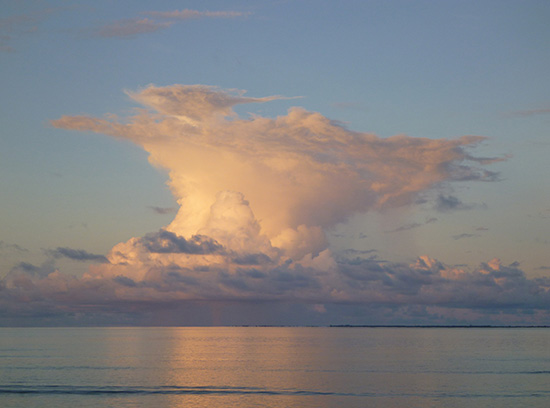Scientists to examine Pacific’s “global chimney”
Storms in the western tropical Pacific influence climate worldwide
Jan 7, 2014 - by Staff
Jan 7, 2014 - by Staff
BOULDER – Even though few people live in the western tropical Pacific Ocean, these remote waters affect billions of people by shaping climate and air chemistry worldwide. Next week, leading scientists will head to the region to better understand its influence on the atmosphere—including how that may change in coming decades if storms over the Pacific become more powerful with rising global temperatures.
With the warmest ocean waters on Earth, the western tropical Pacific fuels a sort of chimney whose output has global reach. The region feeds heat and moisture into huge clusters of thunderstorms that loft gases and particles into the stratosphere, where they spread out over the entire planet and influence the climate.
“To figure out the future of the air above our heads, we need to go to the western Pacific,” said Laura Pan, a scientist at the National Center for Atmospheric Research (NCAR) and one of the principal investigators on the field project. “This region has been called the holy grail for understanding global air transport, because so much surface air gets lifted by the storms and then spreads globally.”
The field project is called CONTRAST (Convective Transport of Active Species in the Tropics). It is funded by the National Science Foundation (NSF), which sponsors NCAR. More than 40 scientists are taking part from NCAR, the University of Maryland, the University of Miami, other universities across the country, and NASA.
CONTRAST, which will be based in Guam, is being coordinated with two other field projects in order to give researchers an especially detailed view of the air masses over the Pacific with a vertical range spanning tens of thousands of feet.
One of these projects, NASA’s Airborne Tropical Tropopause Experiment (ATTREX), will use a Global Hawk, a robotic aerial vehicle, to study upper-atmospheric water vapor, which influences global climate. The other, CAST (Coordinated Airborne Studies in the Tropics) is funded by Britain’s Natural Environment Research Council Facility and will deploy a BAe146 research aircraft that will focus on air near the ocean surface.
Together, the sensor-laden research flights will provide a comprehensive view of the atmosphere from the ocean surface, where gases produced by marine organisms enter the air, to the stratosphere, more than 60,000 feet above.

Showers and thunderstorms over the tropics can grow from isolated systems, as shown here in the Maldives, to larger complexes that loft vast quantities of air from the lower atmosphere to the stratosphere. CONTRAST will examine how such circulations evolve over the western tropical Pacific, where they can influence atmospheric chemistry over wide areas. (Photo courtesy Adam Sobel, Columbia University.)
“It’s a huge region, and that means we have to use multiple aircraft,” said the University of Maryland’s Ross Salawitch, a CONTRAST principal investigator. “We will attempt to stage these three airplanes in harmony to measure the atmospheric composition over the western Pacific when both ocean biology and atmospheric storms are raging.”
As trade winds flow across the tropical Pacific, they push warm water to the west, where it piles up in and near the CONTRAST study region. The waters around Guam have the world’s highest sea surface temperatures of open oceans. They provide heat and moisture to feed clusters of thunderstorms that lift air through the troposphere (the lowest level of the atmosphere) and the tropopause (a cold, shallow region atop the troposphere) and then up into the stratosphere.
Once in the stratosphere—where the air tends to flow horizontally more than rising or sinking—the gases and particles spread out around the world and linger for years or even decades.
Some of the gases, such as ozone and water vapor, affect the amount of energy from the Sun that reaches Earth’s surface. The amount of these gases in the stratosphere is important for the planet’s climate. Other chemicals, such as bromine compounds, have indirect effects by destroying ozone or otherwise altering the chemistry of the stratosphere. And the gases produced by ocean organisms create a signature of marine biology in the stratosphere.
“There are so few measurements of atmospheric composition in this important region of the atmosphere that we expect to be able to significantly advance our understanding with the data we will be able to collect during CONTRAST,” said Elliot Atlas of the University of Miami, a CONTRAST principal investigator.
As atmospheric patterns evolve and sea surface temperatures warm further due to climate change, the storm clusters over the Pacific are likely to influence climate in ways that are now challenging to anticipate, NCAR’s Pan said.
“Understanding the impact of these storms will help us gain ground truth for improving the chemistry-climate models we use to project future climate,” she said.
The CONTRAST team will deploy the NSF/NCAR HIAPER aircraft, a Gulfstream V jet modified for advanced research that will fly at altitudes between about 25,000 and 50,000 feet. Using spectrometers and other instruments on board, the researchers will measure various chemicals and take air samples across a wide region, both in storm clouds and far away from them. The measurements will be analyzed in conjunction with data from the ATTREX Global Hawk (covering altitudes up to 65,000 feet) and CAST BAe146 (with observations from the ocean surface to about 20,000 feet).
The researchers are planning as many as 16 flights, targeting both towering storms that loft fresh air into the stratosphere as well as collapsed storms to examine the composition of the air that remains lower down, in the troposphere.
While the scientists will have considerable follow-up research to do in their labs, some of the airborne instruments will provide real-time measurements to the team. State-of-the-art models of atmospheric chemistry will help guide the research flights in the field, as well as aid in subsequent analysis of the observations.
"There will be a lot of discovery and science in the field,” Pan said.